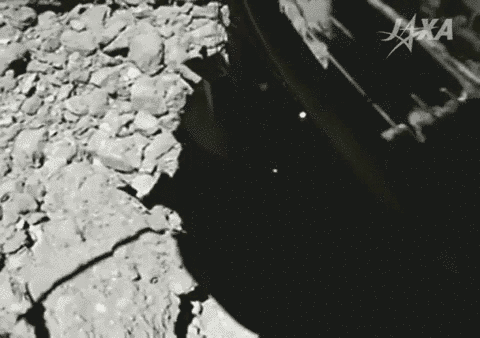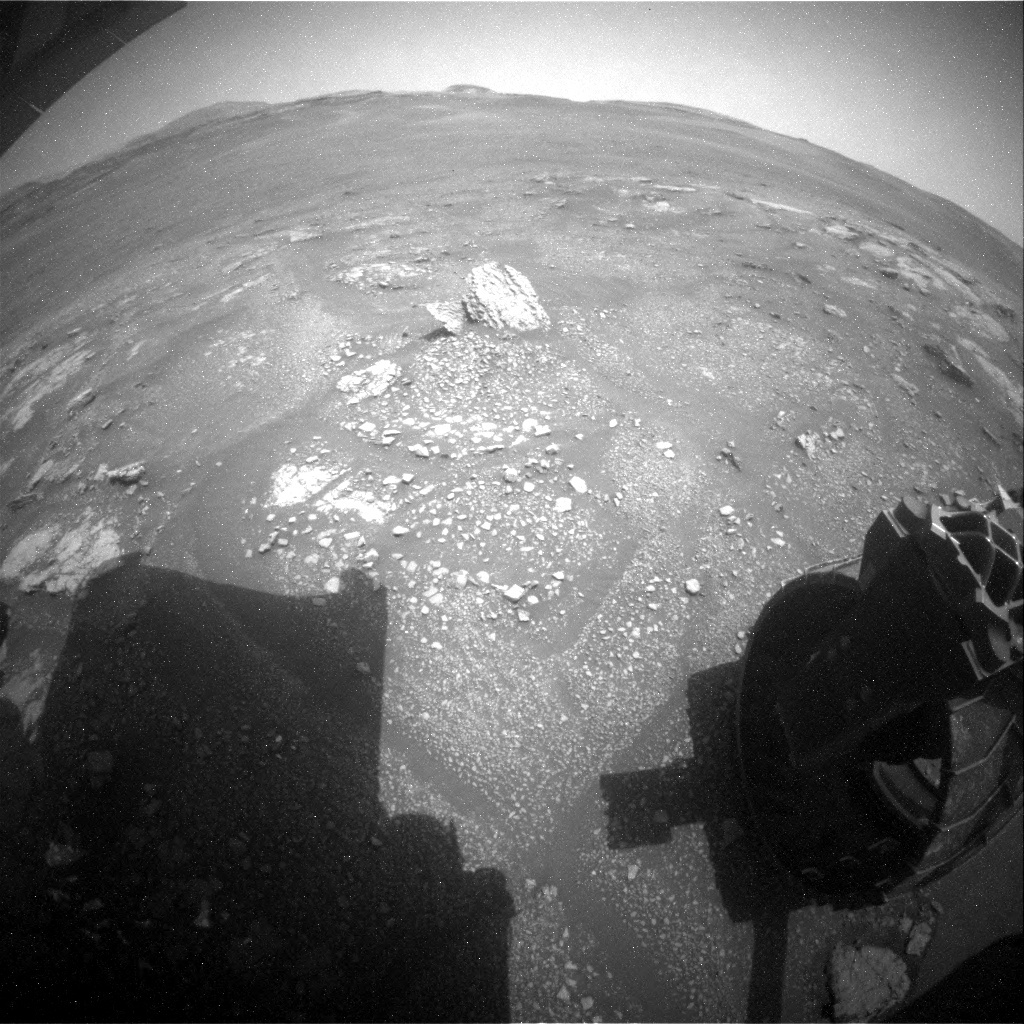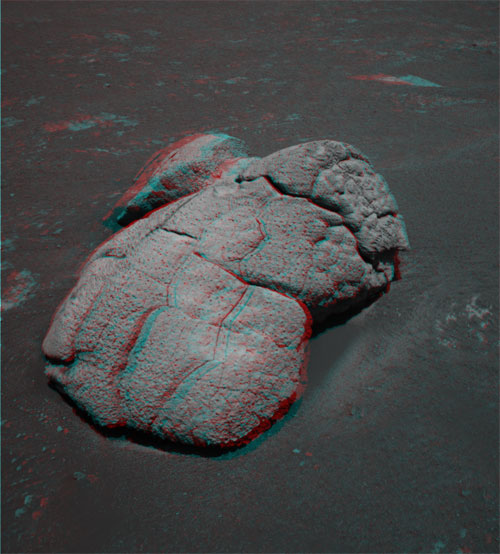MARS: CURIOSITY u krateru GALE Vol II.
ex-iskon-pleme :: Društvo :: Znanost
Page 33 of 50
Page 33 of 50 •  1 ... 18 ... 32, 33, 34 ... 41 ... 50
1 ... 18 ... 32, 33, 34 ... 41 ... 50 
 Re: MARS: CURIOSITY u krateru GALE Vol II.
Re: MARS: CURIOSITY u krateru GALE Vol II.
Logbook entry: 6 March 2019
Excellent news! We just got the data from the first Phobos eclipse observation and the cooling by the shadow passing through the fields of view of the radiometer in about 30 seconds is clearly visible. The cooling is by about 1°C and is thus somewhat larger than expected and certainly better than with the most pessimistic estimates (that would have said, we will not be able to see it at all)! So the team is happy and is rejoicing about the first eclipse on Mars ever observed with a radiometer.
What is the significance of the observation? There is a quantity that scientists call the thermal inertia. This quantity depends on the thermal conductivity of the near surface material, its density and its heat capacity. A small value indicates low thermal conductivity, for instance, or a large porosity (meaning low density) etc. The larger the thermal inertia, the smaller the effect. In particular, if the shadow moves through rapidly and the inertia is large, little effect will be measured. The measurable effect is the more pronounced the smaller the inertia. The team will now have to analyze the data and come up with a model of the uppermost millimeters or so of the surface material. So, it is part of our efforts to measure the geophysical paramters of Mars.
 Quelle: NASA/JPL-Caltech/DLR
Quelle: NASA/JPL-Caltech/DLR
As for the mole, the team has commanded a large number of images to be taken by the cameras on the lander and the arm. Some of the images we already have, indicate that part of the mole is actually visible. The consensus is that the mole is about 30 cm in the regolith and probably still 7cm in the tube of the support structure. It is approximately pointing 15° away from the vertical and has undergone either some rotation or precession of its rotation axis.
It is still healthy but, of course, Its life time is limited - in terms of hammering strokes it can make before it is worn down - although we are not concerned that it would breake soon. Still, the team wants to play it safe and get all the evidence that could become available including seismic data together to see how we can help the mole to overcome the obstacle (or to get through a possible layer of gravel). Once we have all the data, we will decide on how to proceed best.
Stay tuned
Excellent news! We just got the data from the first Phobos eclipse observation and the cooling by the shadow passing through the fields of view of the radiometer in about 30 seconds is clearly visible. The cooling is by about 1°C and is thus somewhat larger than expected and certainly better than with the most pessimistic estimates (that would have said, we will not be able to see it at all)! So the team is happy and is rejoicing about the first eclipse on Mars ever observed with a radiometer.
What is the significance of the observation? There is a quantity that scientists call the thermal inertia. This quantity depends on the thermal conductivity of the near surface material, its density and its heat capacity. A small value indicates low thermal conductivity, for instance, or a large porosity (meaning low density) etc. The larger the thermal inertia, the smaller the effect. In particular, if the shadow moves through rapidly and the inertia is large, little effect will be measured. The measurable effect is the more pronounced the smaller the inertia. The team will now have to analyze the data and come up with a model of the uppermost millimeters or so of the surface material. So, it is part of our efforts to measure the geophysical paramters of Mars.
As for the mole, the team has commanded a large number of images to be taken by the cameras on the lander and the arm. Some of the images we already have, indicate that part of the mole is actually visible. The consensus is that the mole is about 30 cm in the regolith and probably still 7cm in the tube of the support structure. It is approximately pointing 15° away from the vertical and has undergone either some rotation or precession of its rotation axis.
It is still healthy but, of course, Its life time is limited - in terms of hammering strokes it can make before it is worn down - although we are not concerned that it would breake soon. Still, the team wants to play it safe and get all the evidence that could become available including seismic data together to see how we can help the mole to overcome the obstacle (or to get through a possible layer of gravel). Once we have all the data, we will decide on how to proceed best.
Stay tuned
Eroo- Posts : 79056
2016-07-22
 Re: MARS: CURIOSITY u krateru GALE Vol II.
Re: MARS: CURIOSITY u krateru GALE Vol II.
Hayabusa2 moment of touchdown

JAXA
Hayabusa2 moment of touchdown
This animation, extracted from a longer video, shows the moment of Hayabusa2's 21 February 2019 touchdown on asteroid Ryugu.

JAXA
Hayabusa2 moment of touchdown
This animation, extracted from a longer video, shows the moment of Hayabusa2's 21 February 2019 touchdown on asteroid Ryugu.
_________________
Nulla rosa sine spina

Eroo- Posts : 79056
2016-07-22

Eroo- Posts : 79056
2016-07-22

Eroo- Posts : 79056
2016-07-22
 Re: MARS: CURIOSITY u krateru GALE Vol II.
Re: MARS: CURIOSITY u krateru GALE Vol II.
Sol 2340: And objects in the rear-view mirror may appear… interesting!
Written by Susanne Schwenzer on 03.06.2019

NASA's Mars rover Curiosity acquired this image using its Rear Hazard Avoidance Cameras (Rear Hazcams) on Sol 2338 Credit: NASA/JPL-Caltech
Image taken by the Left Rear Hazard Camera onboard NASA's Mars rover Curiosity on Sol 2338 (2019-03-05 10:16:29 UTC). This target has now been named "Muir of Ord."
In the current plan, we start with a dust devil survey to look for them while they are still in season. This is followed by a ChemCam investigation "Schiehallion" and an RMI mosaic on "Motherwell." Mastcam will finish off the investigation with multispectral images on the block in front of us, which contain the previous APXS targets "Fife" and "Arbuthnott." So far, so routine, but then there was the look in the rear-view mirror!
Finishing up at the "Midland Valley" outcrop also included the inspection of a wide range of new images. In those images the team discovered a block that allows a unique 3D view of the rocks in the area. As the rover stands at this moment, the rock of interest is just behind it, with the line of sight and ChemCam line of laser shot blocked by the rover itself. The question was, whether to proceed as planned and drive away from the site, or to turn the rover around and take the opportunity to observe this block from the top and the side. This way, we would gain a three-dimensional view of the layering as well as chemical information. This would be important information to investigate depositional conditions of those rocks, and thus help our understanding of the new environment of the clay-bearing unit, as part of which this rock was deposited. We decided to take the turn.
As a start, in today's plan, the rock was named "Muir of Ord" and - in an unusual manoeuvre only possible because of the very short and well understood drive to turn the rover around - Mastcam will be able to get multispectral imagery in the same sol. Chemical information and MAHLI will add to the investigations in the future. So, stay tuned!
_________________
Nulla rosa sine spina

Eroo- Posts : 79056
2016-07-22

Eroo- Posts : 79056
2016-07-22
 Re: MARS: CURIOSITY u krateru GALE Vol II.
Re: MARS: CURIOSITY u krateru GALE Vol II.
Pogled prema rubu kratera (sjever), na sol 2016. Udaljenost oko 30.-ak km.


_________________
Nulla rosa sine spina

Eroo- Posts : 79056
2016-07-22
 Re: MARS: CURIOSITY u krateru GALE Vol II.
Re: MARS: CURIOSITY u krateru GALE Vol II.
...i izgled pod našim nebom:


_________________
Nulla rosa sine spina

Eroo- Posts : 79056
2016-07-22
 Re: MARS: CURIOSITY u krateru GALE Vol II.
Re: MARS: CURIOSITY u krateru GALE Vol II.
InSight ...zalazak sunca


_________________
Nulla rosa sine spina

Eroo- Posts : 79056
2016-07-22

Eroo- Posts : 79056
2016-07-22
 Re: MARS: CURIOSITY u krateru GALE Vol II.
Re: MARS: CURIOSITY u krateru GALE Vol II.
Updated March 12, 2019, 10:40 a.m. PDT (1:40 p.m EDT): Curiosity experienced a computer reset on its Side-A computer on Wednesday, March 6, 2019 (Sol 2,339), that triggered the rover's safe mode. This was the second computer reset in three weeks; both resets were related to the computer's memory.
The mission team decided to switch from the Side-A computer back to the rover's Side-B computer, which it operated on for most of the mission until November of 2018. Side-B recently experienced its own memory issue; the team has since further diagnosed the matter, reformatting the Side-B computer to isolate areas of "bad" memory. As of today, Curiosity is out of safe mode, and the team is configuring the rover for new science operations in the clay unit. Curiosity is expected to return to science operations as early as Wednesday.
The mission team decided to switch from the Side-A computer back to the rover's Side-B computer, which it operated on for most of the mission until November of 2018. Side-B recently experienced its own memory issue; the team has since further diagnosed the matter, reformatting the Side-B computer to isolate areas of "bad" memory. As of today, Curiosity is out of safe mode, and the team is configuring the rover for new science operations in the clay unit. Curiosity is expected to return to science operations as early as Wednesday.
_________________
Nulla rosa sine spina

Eroo- Posts : 79056
2016-07-22
 Re: MARS: CURIOSITY u krateru GALE Vol II.
Re: MARS: CURIOSITY u krateru GALE Vol II.
Eroo wrote:
Ovaj pejzaž mi i nije stran...
_________________
Pula travel guide
 Re: MARS: CURIOSITY u krateru GALE Vol II.
Re: MARS: CURIOSITY u krateru GALE Vol II.
Sezansko nagomilavanje blata(glina!) na dnu jezera.
Zanimljivo bilo pogledati što je između ...

Zanimljivo bilo pogledati što je između ...

_________________
Nulla rosa sine spina

Eroo- Posts : 79056
2016-07-22
 Re: MARS: CURIOSITY u krateru GALE Vol II.
Re: MARS: CURIOSITY u krateru GALE Vol II.
_________________
Nulla rosa sine spina

Eroo- Posts : 79056
2016-07-22
 Re: MARS: CURIOSITY u krateru GALE Vol II.
Re: MARS: CURIOSITY u krateru GALE Vol II.
Grumen smrznog blata (gline), naknadno "pečenog" sunčevim zračenjem.
Trenutno je u fokusu znanstvenog ispitivanja.

NASA's Mars rover Curiosity acquired this image using its Left Navigation Camera (Navcams) on Sol 2350 Credit: NASA/JPL-Caltech


Possible Mud Cracks Preserved in Martian Rock
The network of cracks in this Martian rock slab called "Old Soaker" may have formed from the drying of a mud layer more than 3 billion years ago. The view spans about 3 feet (90 centimeters) left-to-right and combines three images taken by the MAHLI camera on the arm of NASA's Curiosity Mars rover.
Today was a fun, busy day to plan. Curiosity finally made the drive to a rock called "Muir of Ord," which has a cracked surface. The science team is particularly interested in imaging this rock up close because of the fracture patterns. Cracks like these can form from mud drying out when the original sediments were deposited or after exposure of the rock during weathering (see this rock from the Opportunity rover).


Wonderful Wopmay
This three-dimensional view from the navigation camera on NASA's Mars Exploration Rover Opportunity shows an unusual, lumpy rock informally named "Wopmay" on the lower slopes of "Endurance Crater."
If the cracks on Muir of Ord formed when the sediment was first deposited, they tell us something about the depositional environment. If they formed during weathering, they tell us about processes on the slopes of Mount Sharp. Today, we planned observations to help determine which is more likely.
The science plan starts with contact science on the "Crieff" target, which is on the top surface of Muir of Ord. APXS will perform a short analysis to determine its elemental composition, and MAHLI will image it at progressively higher magnifications to allow us to study the crack shapes in detail. MAHLI will then image the side of Muir of Ord at a target called "Crossroads" to see how the cracks cross the layering in the rock. Once the contact science is complete, ChemCam will analyze Crieff with a 3x3 grid, and Mastcam will take a mosaic of Muir of Ord. ChemCam then analyzes the targets "James," "Kilmarnock," and "Crail" with Mastcam providing context images. Finally, we finish up the science at this spot with two more Mastcams of "Aldons Quarry" and "Small Isles."
But Curiosity is not done for the sol! The next activity is a ~30 meter drive with sequential MARDI images to document the large-scale fracture patterns in the outcrop. Once the drive is over, Curiosity will take typical post drive images, including both Navcam and Mastcam mosaics of the workspace and the future drive direction.
The second sol of our plan includes lots of environmental measurements. The morning activities consist of Mastcam imaging of the sun to characterize dust in the atmosphere, a Navcam movie above the horizon to study atmospheric dynamics, and a Navcam movie looking for dust devils. Afternoon activities include a zenith movie to image clouds and their motion, plus a second set of sun images. Geological activities include an AEGIS ChemCam analysis on a rover-selected target as well as a Mastcam 360° panorama. We are looking forward to interpreting all this great new data.
Trenutno je u fokusu znanstvenog ispitivanja.

NASA's Mars rover Curiosity acquired this image using its Left Navigation Camera (Navcams) on Sol 2350 Credit: NASA/JPL-Caltech


Possible Mud Cracks Preserved in Martian Rock
The network of cracks in this Martian rock slab called "Old Soaker" may have formed from the drying of a mud layer more than 3 billion years ago. The view spans about 3 feet (90 centimeters) left-to-right and combines three images taken by the MAHLI camera on the arm of NASA's Curiosity Mars rover.
Today was a fun, busy day to plan. Curiosity finally made the drive to a rock called "Muir of Ord," which has a cracked surface. The science team is particularly interested in imaging this rock up close because of the fracture patterns. Cracks like these can form from mud drying out when the original sediments were deposited or after exposure of the rock during weathering (see this rock from the Opportunity rover).


Wonderful Wopmay
This three-dimensional view from the navigation camera on NASA's Mars Exploration Rover Opportunity shows an unusual, lumpy rock informally named "Wopmay" on the lower slopes of "Endurance Crater."
If the cracks on Muir of Ord formed when the sediment was first deposited, they tell us something about the depositional environment. If they formed during weathering, they tell us about processes on the slopes of Mount Sharp. Today, we planned observations to help determine which is more likely.
The science plan starts with contact science on the "Crieff" target, which is on the top surface of Muir of Ord. APXS will perform a short analysis to determine its elemental composition, and MAHLI will image it at progressively higher magnifications to allow us to study the crack shapes in detail. MAHLI will then image the side of Muir of Ord at a target called "Crossroads" to see how the cracks cross the layering in the rock. Once the contact science is complete, ChemCam will analyze Crieff with a 3x3 grid, and Mastcam will take a mosaic of Muir of Ord. ChemCam then analyzes the targets "James," "Kilmarnock," and "Crail" with Mastcam providing context images. Finally, we finish up the science at this spot with two more Mastcams of "Aldons Quarry" and "Small Isles."
But Curiosity is not done for the sol! The next activity is a ~30 meter drive with sequential MARDI images to document the large-scale fracture patterns in the outcrop. Once the drive is over, Curiosity will take typical post drive images, including both Navcam and Mastcam mosaics of the workspace and the future drive direction.
The second sol of our plan includes lots of environmental measurements. The morning activities consist of Mastcam imaging of the sun to characterize dust in the atmosphere, a Navcam movie above the horizon to study atmospheric dynamics, and a Navcam movie looking for dust devils. Afternoon activities include a zenith movie to image clouds and their motion, plus a second set of sun images. Geological activities include an AEGIS ChemCam analysis on a rover-selected target as well as a Mastcam 360° panorama. We are looking forward to interpreting all this great new data.

Eroo- Posts : 79056
2016-07-22

Eroo- Posts : 79056
2016-07-22
 Re: MARS: CURIOSITY u krateru GALE Vol II.
Re: MARS: CURIOSITY u krateru GALE Vol II.
sol 2353 novih 30-tak metara...približna lokacija (Ero)


_________________
Nulla rosa sine spina

Eroo- Posts : 79056
2016-07-22
 Re: MARS: CURIOSITY u krateru GALE Vol II.
Re: MARS: CURIOSITY u krateru GALE Vol II.
Stromatolite....Sedimenti+vezivo, biološko ili abiotičko, pitanje je sad.
Nastaju u plitkoj vodi!

Nastaju u plitkoj vodi!


Eroo- Posts : 79056
2016-07-22
 Re: MARS: CURIOSITY u krateru GALE Vol II.
Re: MARS: CURIOSITY u krateru GALE Vol II.
Vidio sam i ovakav komentar:
That would be amazing. Sadly, it's probably not stromatolites..
That would be amazing. Sadly, it's probably not stromatolites..
_________________
Nulla rosa sine spina

Eroo- Posts : 79056
2016-07-22
 Re: MARS: CURIOSITY u krateru GALE Vol II.
Re: MARS: CURIOSITY u krateru GALE Vol II.
 find the nearest fifth third bank
find the nearest fifth third bank_________________
Nulla rosa sine spina

Eroo- Posts : 79056
2016-07-22
Page 33 of 50 •  1 ... 18 ... 32, 33, 34 ... 41 ... 50
1 ... 18 ... 32, 33, 34 ... 41 ... 50 
 Similar topics
Similar topics» MARS: CURIOSITY u krateru GALE
» MARS: CURIOSITY u krateru GALE Vol II.
» MARS: CURIOSITY u krateru GALE Vol II.
» Exciting snimak, upravo pristigao s Marsa (krater Gale, rover Curiosity)
» The latest Selfie from Curiosity taken yesterday on Mars
» MARS: CURIOSITY u krateru GALE Vol II.
» MARS: CURIOSITY u krateru GALE Vol II.
» Exciting snimak, upravo pristigao s Marsa (krater Gale, rover Curiosity)
» The latest Selfie from Curiosity taken yesterday on Mars
ex-iskon-pleme :: Društvo :: Znanost
Page 33 of 50
Permissions in this forum:
You cannot reply to topics in this forum
 Events
Events Latest images
Latest images
 by Eroo 8/3/2019, 17:01
by Eroo 8/3/2019, 17:01




